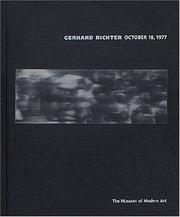| Listing 1 - 2 of 2 |
Sort by
|
Book
ISBN: 9026515901 Year: 2000 Publisher: Lisse Swets en Zeitlinger
Abstract | Keywords | Export | Availability | Bookmark
 Loading...
Loading...Choose an application
- Reference Manager
- EndNote
- RefWorks (Direct export to RefWorks)
Terrorism --- History --- Rote Armee Fraktion --- History.

ISBN: 0870700235 9780870700231 Year: 2000 Publisher: New York The Museum of Modern Art
Abstract | Keywords | Export | Availability | Bookmark
 Loading...
Loading...Choose an application
- Reference Manager
- EndNote
- RefWorks (Direct export to RefWorks)
Destined to rank among the most eloquent and thorough examinations of a major suite of paintings, Gerhard Richter: October 18, 1977 combines a lean, persuasively argued text with an elegantly sober design suited to the subject matter. Richter's 15 black-and-white paintings commemorate the day two leaders of the radical German Baader-Meinhof group, disillusioned men and women in their 30s and early 40s whose loyalty to the dogma of the Red Army Faction had led them to commit numerous terrorist acts, were found dead in their prison cells. Gudrun Ensslin appeared to have hung herself. Andreas Baader had been fatally shot. Jan-Carl Raspe was near death from a bullet wound. Two other members of the group had died in prison earlier in the '70s: Holger Meins after a hunger strike; Ulrike Menihof, by hanging. On the Left, there was widespread suspicion the dead had been murdered. Photographs of the Baader-Meinhof members were ubiquitous in newspapers of the day; their images were as familiar to Germans as machine gun-toting Patty "Tania" Hearst was to Americans. Using photographs as models, Richter painted the dead with a subtle technique--a blurring of certain details and an elegiac use of gray--that calls into question the murkiness of historical "knowledge" and emphasizes the uneasy mixture of compassion and horror evoked by the group's fate. Yet, even though Richter waited until 1988 to paint the series, he was denounced either for glorifying a bunch of killers or for using his international fame to exploit the Left. Author Robert Storr, a curator at MoMA, which now owns the series, answers these arguments by looking systematically at postwar German politics, the tradition of history painting, and the dilemmas and decisions of a leading contemporary painter. --(Cathy Curtis).
Richter, Gerhard --- Richter, Gerhard, --- Rote Armee Fraktion --- In art --- Robert Storr --- kunst --- twintigste eeuw --- schilderkunst --- Duitsland --- Richter Gerhard --- Baader-Meinhof --- 75.071 RICHTER --- Rote Armee Fraktion. --- Red Army Faction --- Baader-Meinhof Gang --- Baader-Meinhof Group --- RAF (Red Army Faction) --- Vörös Hadsereg Frakció --- Richter, Gerhard, - 1932- - 18 Oktober 1977 - Exhibitions --- Richter, Gerhard, - 1932- - 18 Oktober 1977
| Listing 1 - 2 of 2 |
Sort by
|

 Search
Search Feedback
Feedback About UniCat
About UniCat  Help
Help News
News